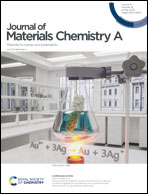High-performance silicon nanocomposite based ionic actuators†
Abstract
Ionic actuators are promising candidates for artificial intelligence by virtue of their fast response and large strain under a low voltage stimulus. However, their actuation performances were limited to inferior ion-sensitive materials and electrodes with rather low mass loading (∼1 mg cm−2). Thicker electrodes with higher mass loading increase ion diffusion limitations during the electrochemical process and hence reduce the utilization of active materials without fully expressing the actuation effect. Here, a highly ion-sensitive silicon nanocomposite with a hierarchical porous structure is designed for ionic actuators. According to ex situ cryogenic TEM results, this material exhibits a large volume strain of 310% at the microscale under a voltage of 0.8 V in a three-electrode system. Additionally, its highly interconnected architecture facilitates rapid ion/electron transport and thus reduces the ion penetration depth across the thickness direction in electrodes. The actuator with a mass loading of 9 mg cm−2 delivered impressive actuation performances, including a wide frequency response from 1 to 20 Hz, superfast response speed within 210 ms, a high blocking force of 71 mN, a large energy density of 10.91 kJ m−3, and excellent cycling stability over 10 000 cycles. Furthermore, a meso-mechanical model is put forward to verify actuation performances and displays great potential for prediction of advanced actuation materials.



 Please wait while we load your content...
Please wait while we load your content...